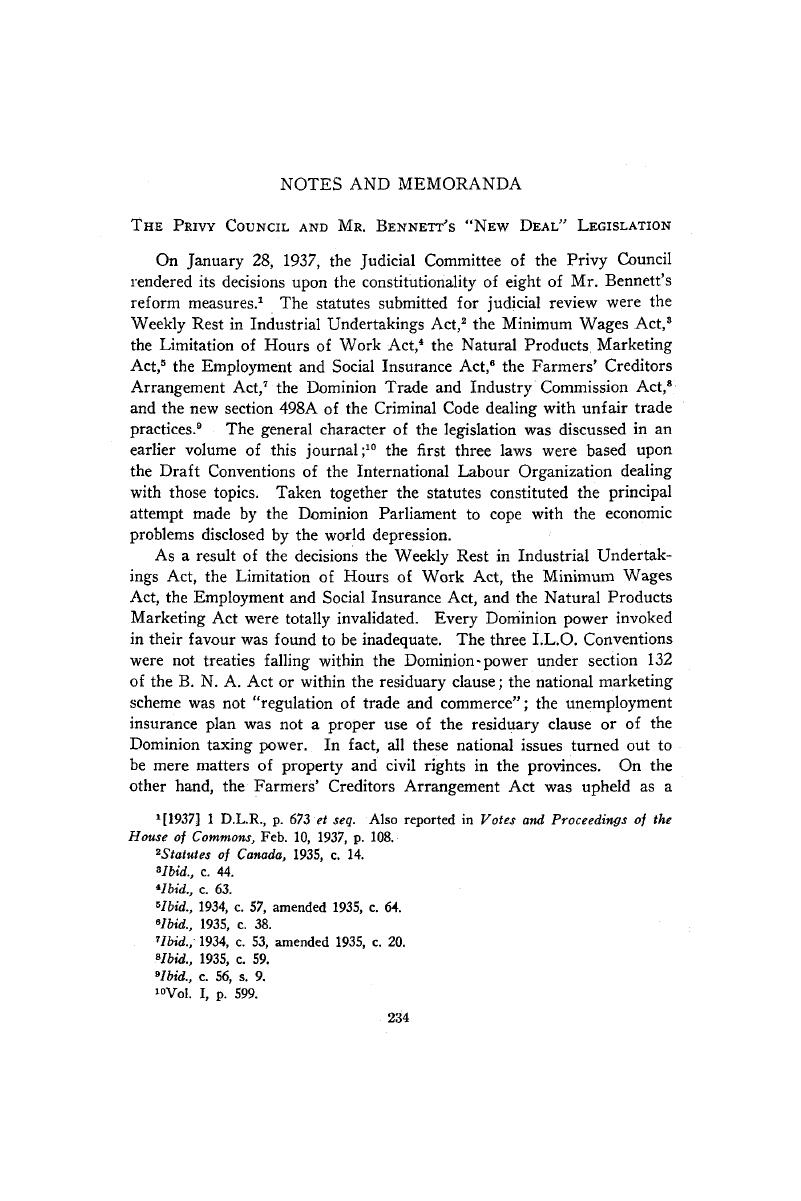Published online by Cambridge University Press: 07 November 2014

1 [1937] 1 D.L.R., p. 673 et seq. Also reported in Votes and Proceedings of the House of Commons, 02 10, 1937, p. 108.Google Scholar
2 Statutes of Canada, 1935, c. 14.
3 Ibid., c. 44.
4 Ibid., c. 63.
5 Ibid., 1934, c. 57, amended 1935, c. 64.
6 Ibid., 1935, c. 38.
7 Ibid., 1934, c. 53, amended 1935, c. 20.
8 Ibid., 1935, c. 59.
9 Ibid., c. 56, s. 9.
10 Vol. I, p. 599.
11 The statutes were submitted to the Supreme Court of Canada on November 5, 1935, on a reference from the Governor-General-in-Council. The decisions were thus based on hypothetical argument and not on concrete cases involving private rights. The distinction, however, though made much of in certain quarters, is of little importance. The time has passed when judgments on abstract questions referred by the executive might be considered as of less binding force than those rendered in the usual manner.
12 [1936] S.C.R. 461.
13 1911, 1-2 Geo. V, c. 28.
14 1913, 3-4 Geo. V, c. 27.
15 R.S.C. 1927, c. 3.
16 Attorney-General for British Columbia v. Attorney-General for Canada, [1924] A.C. 203; Re Aerial Navigation, [1932] A.C. 54.
17 Treaties of Peace Act, 1919, 10 Geo. V, c. 30.
18 Re Regulation and Control of Radio Communication, [1932] A.C. 304.
19 [1937] 1 D.L.R., pp. 673 ff.
20 This argument, it is scarcely necessary to point out, completely begs the question.
21 A discussion by various authors of these and other legal questions involved will be found in the Canadian Bar Review for 1937.
22 [1937] 1 D.L.R., p. 679. The provinces contended that the Dominion had no such power.
23 Lord Atkin (ibid., p. 680) pointed out the distinction between “legislative powers given to the Dominion to perform obligations imposed upon Canada as part of the Empire by an Imperial executive responsible to and controlled by the Imperial Parliament, and the legislative power of the Dominion to perform obligations created by the Dominion executive responsible to and controlled by the Dominion Parliament”. The distinction shows how far the law of the constitution is out of line with political realities, and with the spirit of the Balfour declaration of 1926.
24 Ibid., p. 687.
25 Russell v. The Queen, 7 A.C. 829 as explained by Haldane, Lord in the Snider Case, [1925] A.C. 396, at p. 412.Google Scholar
26 See speech by Cahan, C. H. in Canada, House of Commons Debates (unrevised ed.) 1937, p. 2775.Google Scholar
27 [1936] S.C.R. 398; [1937] 1 D.L.R. 691.
28 Lawson Case, [1931] S.C.R. 357.
29 [1936] S.C.R. 363; [1937] 1 D.L.R. 688.
30 Vol. I, pp. 603-4.
31 [1936] S.C.R. 379; [1937] 1 D.L.R. 702.
32 [1936] S.C.R. 384 (Cannon J. dissenting); [1937] 1 D.L.R. 695.